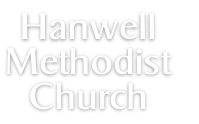




Hanwell Methodist Church
Composed and designed by Ray Garnett

History about Hanwell Methodist Church
More about Hanwell Methodist Church
If you know more information about our Church and its history, then do please get in contact our website designer or one of our Church stewards. Contact details are listed on our Contacts page.
Our Church’s History
Hanwell Methodist Church celebrated its 106th Church Anniversary at the beginning of November 2010, but in fact 106 years is the age of the present building, not the Church itself which dates back from the Wesleyan Society class set up in a house on the corner of the Uxbridge Road and Church Road, Hanwell in 1881. Establishing a Sunday School and growing quickly, it moved into two hired rooms in a private house in nearby Boston Road in 1882, purchasing land for a chapel on the corner of St Dunstan’s Road and Lower Boston Road by the end of that year. A hiatus followed owing to a shortage of funds for building on the land and the Church moved to a rented lecture hall in Boston Road almost opposite Maunder Road. This building still exists and is now a car showroom and garage. The foundation stone for the new chapel was eventually laid late in 1883 once finances were in place and the new chapel was opened in April the next year when music was provided by an American organ.
Once provided with their new premises, Church membership rose steadily. Societies and midweek meetings, not only religious but also of a social and practical nature, flourished, and Sunday School numbers soared, so much that by 1893 (ten years later) the Sunday School had outgrown its premises. A gallery was added but in early 1897 a committee had been set up to look into a new chapel. The present site was purchased in 1899 but the Church was unable to build on it as the Metropolitan Chapel Building Fund Committee would not approve the site and would only pay the interest on money borrowed from the bank for the site purchase for two years to give the Church time to find a site which met with its approval. However, at the end of 1901 the Metropolitan Chapel Building Fund Committee relented and Messrs Gordon and Gunton were engaged as architects.
The Foundation Stone is Laid
Initial instructions were for a Church to seat 600, eventually rising to 1,000 with the addition of galleries at a later date. This figure was reduced to 800 when it became apparent that the galleries would have to be erected at the same time as the building. It was later further reduced to a minimum of 600 following architectural revisions and disappointing tenders for building. Building costs had been capped at £5,000, but even after considerable reductions the cheapest tender could not be reduced past £6,000. On seeking advice as to the advisability of the plans and cost, the Church trustees decided to press on, awarding the building contract to Chas Brightman. A stone laying ceremony took place on 13th April 1904.
The old chapel was eventually sold by auction to the Salvation Army. It has now been refurbished as the William Hobbayne Day Centre for the Elderly to which our Church contributed in a year long fund raising effort for its centenary year in 2004.
The provision of an organ was first discussed in May 1904 and in October 1904 Messrs Bishop and Son, who built the pipe organ that is played today, wrote offering to supply a second-hand organ at a nominal rent, provided the Church paid for installing, insuring and tuning and also placed an order with them for a new pipe organ within 2 or 3 years. However, in view of the building fund’s financial position the Church trustees agreed that they were unable to take up the offer, and on the 9th November the opening services were played on the old American organ. It was obviously felt to be inadequate in the new building as a new organ fund was set up in 1905 and a two manual American organ was purchased in the spring of 1906, with a proviso to sell it to offset costs when a pipe organ could finally be afforded.
The Church mortgage was paid off in June 1909 and immediately the Choir Committee wrote to the trustees pressing them for the launch of an organ project to provide a fitting organ for the Church. With a grant of £250 from Andrew Carnegie the Church was in a position by the end of 1911 to commission Messrs Bishop and Son to erect an electrically powered pipe organ. Although it has cost considerably more to keep it maintained over the years, the original cost of the organ was £630. Pupils learning the organ were charged 6d (6 old pence) per hour to cover the cost of electricity.
The Church Today
The life history of the Church seems to have been marked by great enthusiasm, persistent faith and a decided shortage of funds. Projected schemes have always been followed by curtailment, negotiation and a vigorous round of fund-raising. As you look round the Church enjoy the beauty of our great rear window and the feeling of light and space resulting from the simplicity of the side windows and the use of hammer beams and massive external wall buttresses to support the extensive roof span without internal pillars.
Notice the floating galleries, which, until the front of the Church was remodelled as our millennium project, were largely supported by the wall behind the back pew, (now removed and replaced by the two pillars in the entrance hall.) The pews, pulpit and galleries are original and of pitch pine, although the front of the galleries and the organ were painted in the early 1960s when the furniture inside the altar rail was purchased. The alter rail itself is original but its supports were modernised during the millennium changes.
It is a worthy place in which to worship God.
Click here to visit recollections from a Church member.
Picture of Hanwell Methodist Church in the snow in 1906
drawn by a local artist
Picture of our stained glass window at the rear of our Church
To see more pictures of our rooms and facilities do visit
our Facilities page.
| Search |
| Facilities |
| History |
| Recollections |
| Links |
| Privacy Notice |
| Safeguarding |
| Site Map |
| Church Rotas |
| Church Stewards |
| Gift Aid |
| Minister's Page |
| JMA |
| Junior Church |
| Rainbows |
| Scouts |
| Wednesday Coffee |
| Map |